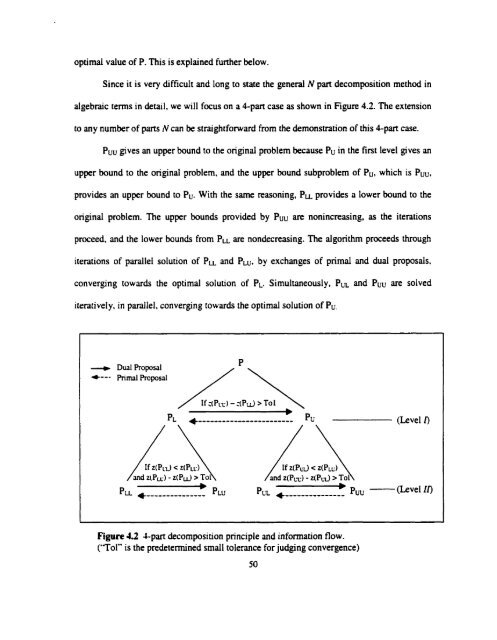X - UWSpace - University of Waterloo
X - UWSpace - University of Waterloo
X - UWSpace - University of Waterloo
Create successful ePaper yourself
Turn your PDF publications into a flip-book with our unique Google optimized e-Paper software.
optimal value <strong>of</strong> P. This is explained further below.<br />
Since it is very diffxcult and long to state the general N part decomposition method in<br />
algebraic terms in detail. we will focus on a Cpart case as shown in Figure 4.2. The extension<br />
to any number <strong>of</strong> parts Ncan be straightfoward from the demonstration <strong>of</strong> this Cpart case.<br />
PUU gives an upper bound to the original problem because Pu in the fint level gives an<br />
upper bound to the original problem. and the upper bound subproblem <strong>of</strong> Pu, which is Puv.<br />
provides an upper bound to Pu. With the same reasoning, Pu. provides a lower bound to the<br />
original problem. The upper bounds provided by Pvv are nonincreasing. as the iterations<br />
proceed. and the lower bounds from PLL are nondecreasing. The algorithm proceeds through<br />
iterations <strong>of</strong> parailel solution <strong>of</strong> PLL and PLU, by exchanges <strong>of</strong> primd and dual proposals.<br />
converging towards the optimal solution <strong>of</strong> PL. Simultaneously, PLI and Puu are solved<br />
iteratively. in parallel, converging towards the optimal solution <strong>of</strong> Pu.<br />
Figure 4.2 lpart decomposition principle and information flow.<br />
('Tol" is the predetermined srnall tolemce for judging convergence)
















